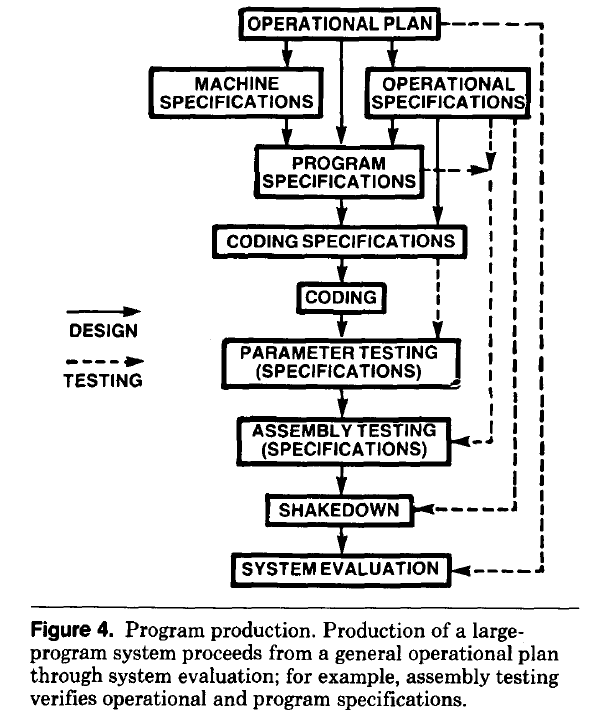Archive
Agile and Waterfall as community norms
While rapidly evolving computer hardware has been a topic of frequent public discussion since the first electronic computer, it has taken over 40 years for the issue of rapidly evolving customer requirements to become a frequent topic of public discussion (thanks to the Internet).
The following quote is from the Opening Address, by Andrew Booth, of the 1959 Working Conference on Automatic Programming of Digital Computers (published as the first “Annual Review in Automatic Programming”):
'Users do not know what they wish to do.' This is a profound truth. Anyone who has had the running of a computing machine, and, especially, the running of such a machine when machines were rare and computing time was of extreme value, will know, with exasperation, of the user who presents a likely problem and who, after a considerable time both of machine and of programmer, is presented with an answer. He then either has lost interest in the problem altogether, or alternatively has decided that he wants something else. |
Why did the issue of evolving customer requirements lurk in the shadows for so long?
Some of the reasons include:
- established production techniques were applied to the process of building software systems. What is now known in software circles as the Waterfall model was/is an established technique. The figure below is from the 1956 paper Production of Large Computer Programs by Herbert Benington (Winston Royce’s 1970 paper has become known as the paper that introduced Waterfall, but the contents actually propose adding iterations to what Royce treats as an established process):

- management do not appreciate how quickly requirements can change (at least until they have experience of application development). In the 1980s, when microcomputers were first being adopted by businesses, I had many conversations with domain experts who were novice programmers building their first application for their business/customers. They were invariably surprised by the rate at which requirements changed, as development progressed.
While in public the issue lurked in the shadows, my experience is that projects claiming to be using Waterfall invariably had back-channel iterations, and requirements were traded, i.e., drop those and add these. Pre-Internet, any schedule involving more than two releases a year could be claimed to be making frequent releases.
Managers claimed to be using Waterfall because it was what everybody else did (yes, some used it because it was the most effective technique for their situation, and on some new projects it may still be the most effective technique).
Now that the issue of rapidly evolving requirements is out of the closet, what’s to stop Agile, in some form, being widely used when ‘rapidly evolving’ needs to be handled?
Discussion around Agile focuses on customers and developers, with middle management not getting much of a look-in. Companies using Agile don’t have many layers of management. Switching to Agile results in a lot of power shifting from middle management to development teams, in fact, these middle managers now look surplus to requirements. No manager is going to support switching to a development approach that makes them redundant.
Adam Yuret has another theory for why Agile won’t spread within enterprises. Making developers the arbiters of maximizing customer value prevents executives mandating new product features that further their own agenda, e.g., adding features that their boss likes, but have little customer demand.
The management incentives against using Agile in practice does not prevent claims being made about using Agile.
Now that Agile is what everybody claims to be using, managers who don’t want to stand out from the crowd find a way of being part of the community.
Creating and evolving a programming language: funding
The funding for artists and designers/implementors of programming languages shares some similarities.
Rich patrons used to sponsor a few talented painters/sculptors/etc, although many artists had no sponsors and worked for little or no money. Designers of programming languages sometimes have a rich patron, in the form of a company looking to gain some commercial advantage, with most language designers have a day job and work on their side project that might have a connection to their job (e.g., researchers).
Why would a rich patron sponsor the creation of an art work/language?
Possible reasons include: Enhancing the patron’s reputation within the culture in which they move (attracting followers, social or commercial), and influencing people’s thinking (to have views that are more in line with those of the patron).
The during 2009-2012 it suddenly became fashionable for major tech companies to have their own home-grown corporate language: Go, Rust, Dart and Typescript are some of the languages that achieved a notable level of brand recognition. Microsoft, with its long-standing focus on developers, was ahead of the game, with the introduction of F# in 2005 (and other languages in earlier and later years). The introduction of Swift and Hack in 2014 were driven by solid commercial motives (i.e., control of developers and reduced maintenance costs respectively); Google’s adoption of Kotlin, introduced by a minor patron in 2011, was driven by their losing of the Oracle Java lawsuit.
Less rich patrons also sponsor languages, with the idiosyncratic Ivor Tiefenbrun even sponsoring the creation of a bespoke cpu to speed up the execution of programs written in the company language.
The benefits of having a rich sponsor is the opportunity it provides to continue working on what has been created, evolving it into something new.
Self sponsored individuals and groups also create new languages, with recent more well known examples including Clojure and Julia.
What opportunities are available for initially self sponsored individuals to support themselves, while they continue to work on what has been created?
The growth of the middle class, and its interest in art, provided a means for artists to fund their work by attracting smaller sums from a wider audience.
In the last 10-15 years, some language creators have fostered a community driven approach to evolving and promoting their work. As well as being directly involved in working on the language and its infrastructure, members of a community may also contribute or help raise funds. There has been a tiny trickle of developers leaving their day job to work full time on ‘their’ language.
The term Hedonism driven development is a good description of this kind of community development.
People have been creating new languages since computers were invented, and I don’t expect this desire to create new languages to stop anytime soon. How long might a language community be expected to last?
Having lots of commercially important code implemented in a language creates an incentive for that language’s continual existence, e.g., companies paying for support. When little or co commercial important code is available to create an external incentive, a language community will continue to be active for as long as its members invest in it. The plot below shows the lifetime of 32 secular and 19 religious 19th century American utopian communities, based on their size at foundation; lines are fitted loess regression (code+data):

How many self-sustaining language communities are there, and how many might the world’s population support?
My tracking of new language communities is a side effect of the blogs I follow and the few community sites a visit regularly; so a tiny subset of the possibilities. I know of a handful of ‘new’ language communities; with ‘new’ as in not having a Wikipedia page (yet).
One list contains, up until 2005, 7,446 languages. I would not be surprised if this was off by almost an order of magnitude. Wikipedia has a very idiosyncratic and brief timeline of programming languages, and a very incomplete list of programming languages.
I await a future social science PhD thesis for a more thorough analysis of current numbers.
Lisp and functional languages discourage free riders
While many developers have a favorite programming language, there are a few who believe they have found the One True Language and refuse to even consider coding in another language.
Why is the One True Language invariably a dialect of Lisp or a functional language?
I think the reason is the same as why strict churches are strong, both these language families make life difficult for free riders, i.e., the casual programmer.
Superficially Lisp-like languages look unwelcoming because of all those brackets and the tiresome reverse polish notation, but once past these surface speed bumps life is not a bed of roses, there are mind bending language challenges to master at every abstraction level; developers get sucked into the community working on mastering each level (this suggests an alternative explanation that coding in Lisp is a way of continuing to play Dungeons & Dragons while appearing to work).
True functional languages don’t have global variables and certainly don’t let you create stateful information. The self-flagulation no global variable languages have a limited clientèle; its the writing of programs that don’t make use of side-effects (e.g., iteration via recursion, not explicit loops) that marks out the true community members; a short conversation with a developer is enough to tell whether they are one-of-us who joyfully tells the world of their latest assignment-free solution to an apparently intractable problem (intractable in the sense of appearing to require the use of assignment statements). There are always umpteen different ways of writing something in functional languages, providing plenty of scope for sects to splinter off by requiring disciples to follow a particular approved style.
Why have Lisp and functional programming continued to survive for so long? Some interesting research on communal societies has found a correlation between the number of costly requirements entailed by community membership and community longevity, the greater the number of costly requirements the longer a community survives. Having sunk so much time and effort into the costly signaling required for community membership, people are loath to leave it all behind.
Recent Comments